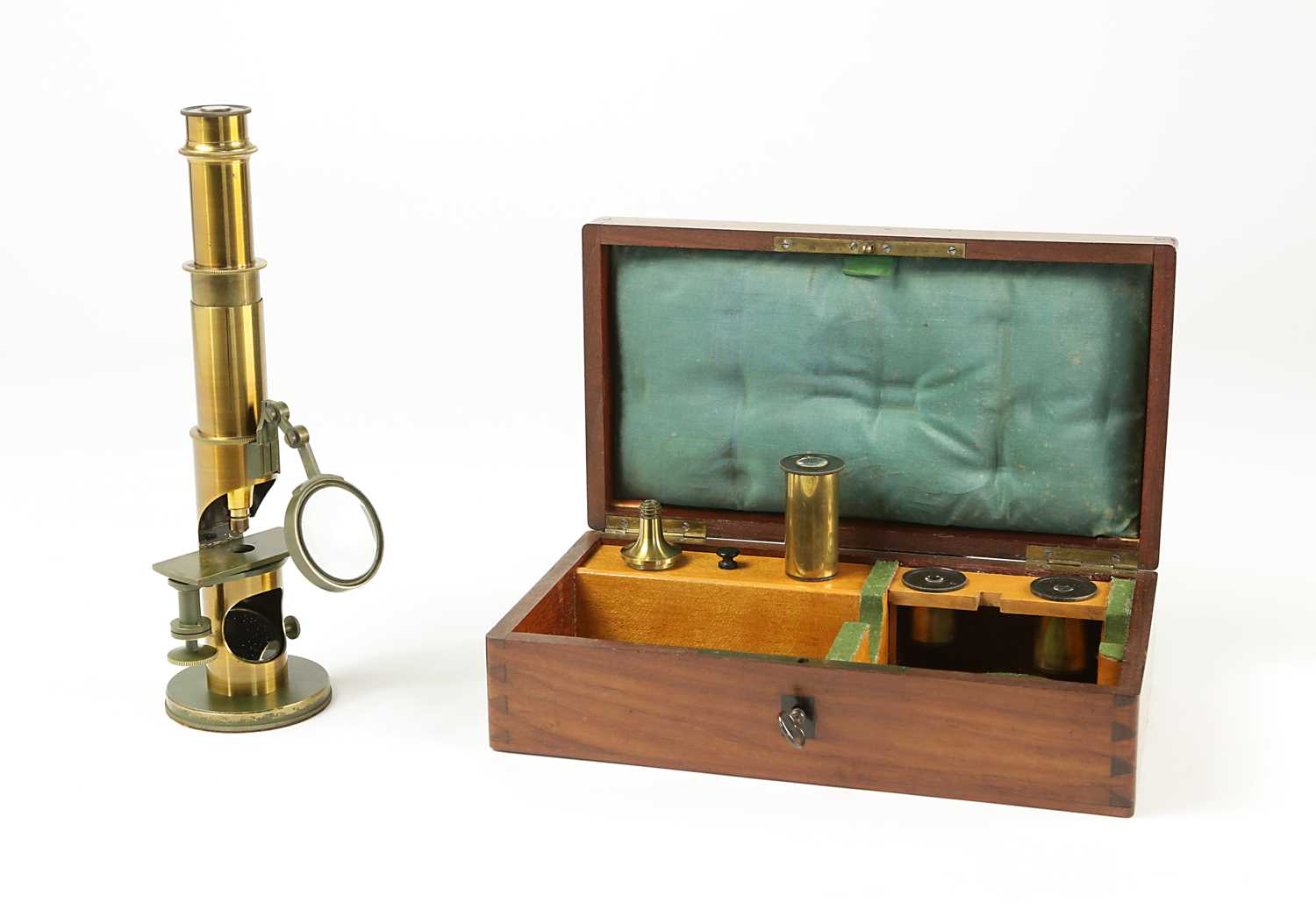1st May, 2000 12:00
Instruments of Science and Technology
96
A Rare George Oberhaeuser (1855) Drum Microscope
A Rare George Oberhaeuser (1855) Drum Microscope Achromatique Réduit.
Paris, France, circa 1855.
Signed 'Gerges Oberhaeuser, Place Dauphine 19, Paris', on the tube, the instrument made of brass and steel. The lighting is provided by a concave mirror and a revolver pinhole. The pull-out tube is moved with the free hand for rough adjustment, fine focusing is achieved by lifting the tabletop using a knurled screw, which can be operated with the microscopist's hand comfortably placed next to the instrument.
The microscope is equipped with objective No. 4 and an additional set of objectives No. 7 as well as eyepieces No. 1 , two pieces No. 3 and No. 5 and a detachable reflected-light magnifier.
Measurement: H. 28 cm.
catalogue Note: Johann Georg Oberhäuser, born on July 16, 1798 as the son of a Bavarian master wood turner in Ansbach (Middle Franconia), attended high school and wanted to become an engineer. However, due to the early death of his father, in 1812 he was forced to join the university mechanic du Mouceau in Würzburg as an apprentice mechanic. After three years his teacher died and Oberhäuser went to Paris as a mechanic's assistant in the spring of 1816. There he managed to get in touch with competent specialists and so he was able to set up his own business with Trécourt and Bouquet as early as 1830. However, Oberhäuser soon separated from his partners. Binoculars and microscopes become the main products.
In 1848, Oberhäuser introduced the horseshoe tripod, which was adopted by all leading manufacturers and remained in use for almost 100 years. Oberhäuser also standardized the tube length at 160 mm at the instigation of the anatomists of the time. This keeps the microscope small enough to view wet objects vertically, which was difficult to do with the British instruments of the time. In doing so, Oberhäuser designed his microscopes as simply as possible, without any technical refinements, again in complete contrast to English instruments. Rough adjustment is done by moving the tube by hand, while a micrometer screw is only available for fine focus. This simple operation enables researchers to to concentrate fully on their microscopic work. Microscopes from Oberhäuser's workshop are very popular because of their excellent lenses and the practical and relatively inexpensive horseshoe tripods.
Estimate: 400-600
Sold for €812
A Rare George Oberhaeuser (1855) Drum Microscope Achromatique Réduit.
Paris, France, circa 1855.
Signed 'Gerges Oberhaeuser, Place Dauphine 19, Paris', on the tube, the instrument made of brass and steel. The lighting is provided by a concave mirror and a revolver pinhole. The pull-out tube is moved with the free hand for rough adjustment, fine focusing is achieved by lifting the tabletop using a knurled screw, which can be operated with the microscopist's hand comfortably placed next to the instrument.
The microscope is equipped with objective No. 4 and an additional set of objectives No. 7 as well as eyepieces No. 1 , two pieces No. 3 and No. 5 and a detachable reflected-light magnifier.
Measurement: H. 28 cm.
catalogue Note: Johann Georg Oberhäuser, born on July 16, 1798 as the son of a Bavarian master wood turner in Ansbach (Middle Franconia), attended high school and wanted to become an engineer. However, due to the early death of his father, in 1812 he was forced to join the university mechanic du Mouceau in Würzburg as an apprentice mechanic. After three years his teacher died and Oberhäuser went to Paris as a mechanic's assistant in the spring of 1816. There he managed to get in touch with competent specialists and so he was able to set up his own business with Trécourt and Bouquet as early as 1830. However, Oberhäuser soon separated from his partners. Binoculars and microscopes become the main products.
In 1848, Oberhäuser introduced the horseshoe tripod, which was adopted by all leading manufacturers and remained in use for almost 100 years. Oberhäuser also standardized the tube length at 160 mm at the instigation of the anatomists of the time. This keeps the microscope small enough to view wet objects vertically, which was difficult to do with the British instruments of the time. In doing so, Oberhäuser designed his microscopes as simply as possible, without any technical refinements, again in complete contrast to English instruments. Rough adjustment is done by moving the tube by hand, while a micrometer screw is only available for fine focus. This simple operation enables researchers to to concentrate fully on their microscopic work. Microscopes from Oberhäuser's workshop are very popular because of their excellent lenses and the practical and relatively inexpensive horseshoe tripods.
Estimate: 400-600
Auction: Instruments of Science and Technology, 1st May, 2000
Hessink's proudly presents the sale of a fine single owner collection of Instruments of Science and Technology. The sale offers you a great opportunity to purchase beautiful selection of globes, microscopes, telescopes, medical, drawing, surveying and navigational instruments from famous instrument makersfrom the 17th to the 20th century.
